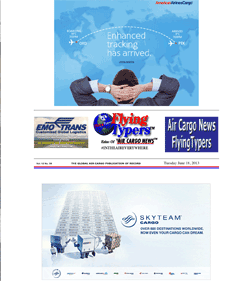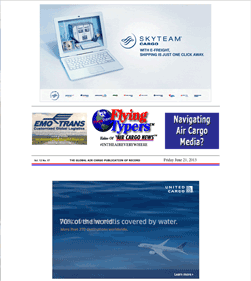
 ogistics demand from the emerging
markets project sector is going
from strength to strength, providing
some relief for under-pressure
air charter and freighter operators.
ogistics demand from the emerging
markets project sector is going
from strength to strength, providing
some relief for under-pressure
air charter and freighter operators.
Back in 2007-2008, major infrastructure,
energy, and offshore projects
were rapidly moving forward
around the world, on the back
of strong global economic growth.
The size of many of these undertakings
meant that demand for many specialist
transport solutions remained
relatively perky, even once
the seriousness of the downturn
that became the Global Financial
Crisis became apparent.
 Quite
simply, in many cases it was
more expensive to delay or cancel
projects than to complete them. Quite
simply, in many cases it was
more expensive to delay or cancel
projects than to complete them.
But
after the initial time lag,
reality did indeed bite.
The
pipeline of new projects dried
up, and this hit the demand
for projects’ logistics
services across the modes.
Only
in the last year or two has
the industry started to show
clear evidence of recovery,
particularly in emerging markets
in Asia, the Middle East, and
Africa.
FlyingTypers
interviewed a number of leading
forwarding executives to see
how they utilize air freight
solutions as part of major project
logistics contracts.
“Working
in the project cargo sector
always involves sending some
shipments by air, particularly
for time-sensitive parts that
cannot be delayed as they play
a pivotal role in a turnkey
project,” explained Per
Thörnblom, GAC Group Project
Logistics Manager.
Most
forwarders’ first option
if air freight is required is
to use bellyhold capacity and,
in the current market, capacity
is rarely an issue. “Airlines
are hungry for cargo at a time
when the highly competitive
market is forcing passenger
ticket prices down,” said
Thörnblom. “This
is especially valid on the main
routes to and from China, the
United States, and Europe etc.”
However,
where bellyhold space is not
available, scheduled freighters
are usually the next best alternative.
Failing that, capacity is chartered
in.
“In
the majority of cases, shippers
will require charters or freighter
services to meet deadline requirements
that would have large penalties
for not fulfilling milestone/deadline
commitments, or lost revenue
from production, which would
outweigh the cost of charters/freighters,”
said Grant Wattman, President
and CEO of Agility’s Project
Logistics team.
 “Agility
most recently had just such
an occasion this past December.
Our client had a project for
a Petropiac Plant under construction
where critical components were
required. These components prevented
the plant from being operational,
and the Agility team utilized
full charter and general freighter
services to satisfy client requirements.” “Agility
most recently had just such
an occasion this past December.
Our client had a project for
a Petropiac Plant under construction
where critical components were
required. These components prevented
the plant from being operational,
and the Agility team utilized
full charter and general freighter
services to satisfy client requirements.”
Switzerland-based
Panalpina only charters aircraft
when shipments are too big to
be carried on normal line haul
flights and/or when the client
needs the cargo at destination
in one lot and not scattered
over several flights. This typically
applies to telecoms equipment,
automotive parts, or temperature-controlled
pharmaceuticals.
Charters
might also be arranged when
the shipment is outsized and/or
overweight and cannot be loaded
into a standard freighter, which
has been the case in recent
shipments of cable reels going
to Kazakhstan via Panalpina,
with each reel weighing 25 tons
and 4 meters high, and oil-well
equipment in pieces weighing
58 tons, 10 meters long, and
3 meters wide, that were going
to the UAE.
“Or
we charter or part charter with
flight diversion if the final
destination is not served by
a regular freighter schedule—for
example, telecoms equipment
to destinations in Africa, and
automotive as well as oil and
gas parts from North America
to South America etc.,”
said Robert Boetzer, Panalpina’s
Head of Corporate Charter and
Emergency Services, based in
Luxembourg.
“And
we charter an aircraft if the
consignee needs the cargo ‘now’
and not tomorrow or in a few
days. For example, if there
is potential risk of a line
shut down in a plant, or an
oil rig has stopped operating.”
Where
standard freighters in the B747F,
MD11F, DC10F, and A330F range
are not large enough for specific
pieces or cannot be handled
by airports, forwarders then
turn to IL76s and AN 125s.
 “The
deciding factors on using a
freighter for outsized cargo
are strictly dictated by the
dimensions and weight of the
freight to be transported,”
explained Roland Zach, VP of
Starbroker Americas and Head
of Global Charter at DHL Global
Forwarding. “Whenever
we receive a charter request
from one of our customers, the
first step we take is to check
what type of aircraft will be
required to move the shipment
from origin to destination. “The
deciding factors on using a
freighter for outsized cargo
are strictly dictated by the
dimensions and weight of the
freight to be transported,”
explained Roland Zach, VP of
Starbroker Americas and Head
of Global Charter at DHL Global
Forwarding. “Whenever
we receive a charter request
from one of our customers, the
first step we take is to check
what type of aircraft will be
required to move the shipment
from origin to destination.
“We
have moved many different commodities
on the Russian aircrafts—Ilyushin-76
(IL76) and Antonov-124 (AN124)—among
them excavators, aircraft fuselages
and wings, oil and energy equipment
etc.
“The
availability of these type of
aircrafts varies; at times you
are able to book an AN124 or
IL76 at very short notice, but
then there are other times where
it may take you between two
to four weeks to get your hands
on an aircraft, especially the
AN124s.
“These
types of aircrafts are also
heavily used by militaries around
the world and, depending on
what moves they have booked
and planned, availability can
change drastically.
“The
pricing of these aircraft is
subject to the route you are
contracting to fly and the total
payload to be moved, but a big
portion of the pricing also
depends on the positioning and
the de-positioning of the aircraft.”
Indeed, negotiating charter
rates for all types of freighters
is an art rather than a science
according to most forwarders,
although capacity is not usually
an issue unless there is a massive
relief operation going on, such
as Haiti’s disastrous
earthquake in 2010, when wide-bodied
capacity ran short in the rush
to airlift relief.
“As
in every business environment,
supply and demand and negotiation
skills determine the rate,”
said Boetzer. “Rates do
vary by route and weight of
the cargo and type of aircraft
used. The bigger the aircraft
and the longer the distance,
the higher the rate, of course.
“Also,
the higher the weight the less
range you have with one fuel
tank. Consequently, more technical
stops for refueling are needed.
All of this has an influence
on the operational costs that
are calculated into the charter
rate.”
SkyKing
|









 urope’s
carriers claim the Middle East’s
most rapidly expanding State-owned
airlines—Qatar Airways,
Emirates, and Etihad—are
benefitting from unfair competitive
advantages, which are enabling
them to seize market share.
urope’s
carriers claim the Middle East’s
most rapidly expanding State-owned
airlines—Qatar Airways,
Emirates, and Etihad—are
benefitting from unfair competitive
advantages, which are enabling
them to seize market share.
 ogistics demand from the emerging
markets project sector is going
from strength to strength, providing
some relief for under-pressure
air charter and freighter operators.
ogistics demand from the emerging
markets project sector is going
from strength to strength, providing
some relief for under-pressure
air charter and freighter operators. Quite
simply, in many cases it was
more expensive to delay or cancel
projects than to complete them.
Quite
simply, in many cases it was
more expensive to delay or cancel
projects than to complete them. “Agility
most recently had just such
an occasion this past December.
Our client had a project for
a Petropiac Plant under construction
where critical components were
required. These components prevented
the plant from being operational,
and the Agility team utilized
full charter and general freighter
services to satisfy client requirements.”
“Agility
most recently had just such
an occasion this past December.
Our client had a project for
a Petropiac Plant under construction
where critical components were
required. These components prevented
the plant from being operational,
and the Agility team utilized
full charter and general freighter
services to satisfy client requirements.” “The
deciding factors on using a
freighter for outsized cargo
are strictly dictated by the
dimensions and weight of the
freight to be transported,”
explained Roland Zach, VP of
Starbroker Americas and Head
of Global Charter at DHL Global
Forwarding. “Whenever
we receive a charter request
from one of our customers, the
first step we take is to check
what type of aircraft will be
required to move the shipment
from origin to destination.
“The
deciding factors on using a
freighter for outsized cargo
are strictly dictated by the
dimensions and weight of the
freight to be transported,”
explained Roland Zach, VP of
Starbroker Americas and Head
of Global Charter at DHL Global
Forwarding. “Whenever
we receive a charter request
from one of our customers, the
first step we take is to check
what type of aircraft will be
required to move the shipment
from origin to destination. RE:
RE:


